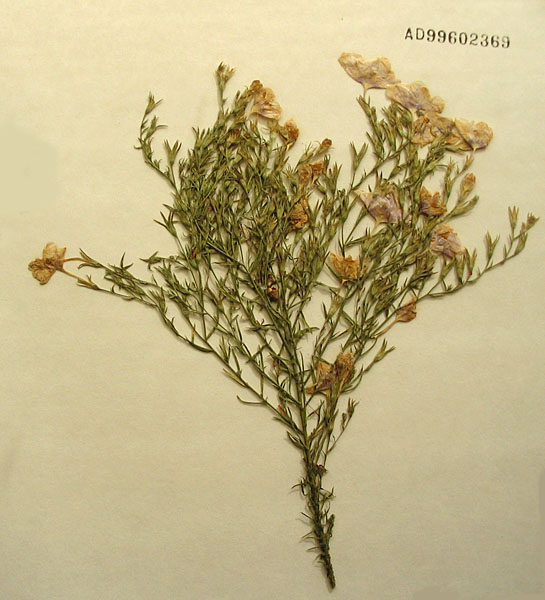 Herbarium specimen (AD). |
 Closer view of herbarium specimen (AD). |
 Line drawing by B. Osborn (Flora of Australia , vol. 29). |

Synonymy
*Nierembergia hippomanica Miers, London. J. Bot. 5: 168 (1846)
T: From Argentina; types probably in BM, in Miers original herbarium or in K, in Hooker's herbarium.
Miers original description of this species can be seen on the web in the books digitised by Google and the pl. 18 illustration of the species referred to in this description in his Illustrations of South American Plants can be seen at http://www.botanicus.org/page/823291
Description
Herb with almost woody rootstock and many, slender stems to 45 cm tall, pubescent with minute simple hairs.
Leaves linear, sessile, 18–25 mm long, 1–1.5 mm wide.
Pedicels 2–5 mm long. Calyx obconical; tube 4–6 mm long, the veins conspicuous; lobes narrowly triangular, 5–6 mm long. Corolla-tube 9–10 mm long, 1 mm diam., abruptly expanded into rotate to broadly stellate limb 15–25 mm diam., the lobes rounded, intense violet with yellow eye. Staminal filaments 5–6 mm long, sparsely glandular-pubescent. Stigma umbrella-like over anthers.
Capsule elliptic, 3–4 mm long. Seeds c. 1 mm long, dark brown to black.
Distribution and ecology
Native to Brazil and Argentina in South America, this is a very infrequent weed of waste ground, recorded only from scattered localities in north-eastern N.S.W.
Common name
Cup Flower
Notes
A variable species with c. 12 varieties.
Australian material appears closest to N. hippomanica var. caerulea (Miers) Millan, although some material has previously been identified as N. hippomanica var. violacea Millan.
Suspected of being toxic to horses and poultry. The poisoning of horses was mentioned in the very first description of this plant when Miers recorded "said by the Gauchos to be very poisonous to horses". (see protologue in London J. Bot. 5: 168 which has been digitised by Google and is available on the web) and the specific epithet is a reference to this property.
Further information about the toxic properties of this plant can be found with a search in the FDA Poisonous Plant Database
Selected specimens
N.S.W.: near Wellington, D.F. Blaxell 691 (NSW).
Derivation of epithet
From Greek hippomanes, a reference to plants which poison horses.
Images and information on web
A series of images of Nierembergia hippomanica can be seen on the Plants Database site at http://davesgarden.com/pdb/showimage/20616/ and a photograph can also be seen at www.desert-tropicals.com/Plants/Solanaceae/Nierembergia_violacea.html
Further information about the toxic properties of this plant can be found with a search in the FDA Poisonous Plant Database